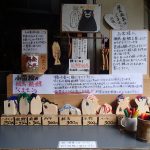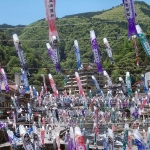Tsuetate Onsen
A hidden valley in the far north of Kumamoto nicknamed ‘Kyushu’s inner sanctum’, the once lively Tsuetate onsen resort has a 1800 year history and is still a fascinating place to visit, not least because of its faded glory and step back in time Showa era atmosphere. The hot springs still function and are renowned for their reputed health giving properties.
Get Steaming
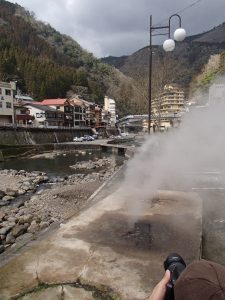
 Tsuetate has steam in abundance, billowing out along the river banks and over rooftops, channelled through rickety and rusting pipes giving the village a special ambiance. (For Studio Gibli fans picture a mix of scenes from Laputa and Sen to Chihiro.)
Tsuetate has steam in abundance, billowing out along the river banks and over rooftops, channelled through rickety and rusting pipes giving the village a special ambiance. (For Studio Gibli fans picture a mix of scenes from Laputa and Sen to Chihiro.)
Tsuetate is famous for its special steam baths, which you can try at many of the ryokan.
Another speciality is steam cooked food. Take advantage of the free food steamers by the riverside to make yourself a snack, grab a wooden steamer box, place it over a steam vent fill it with fresh vegetables or eggs (sweet potatoes are a favourite) put the wooden lid on and before you know it they’ll be cooked to perfection.
The ‘Sedoya’
The ‘sedoya’ is the name given to the narrow passages, tunnels, back alleys and steps that lead you between the buildings lining both sides of the river, fun to explore and great to photograph. Tucked between abandoned hotels you will come across small ryokan and places selling the Tsutate sweet egg pudding – a variety of steamed egg custard that is a popular souvenir.
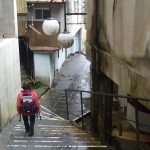
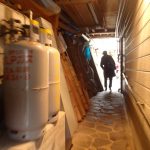
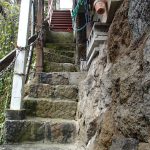
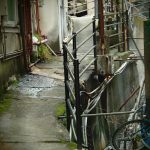
The Hot Springs
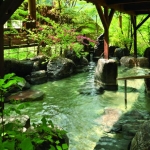 The Tsuetate hot spring is boiling hot – literally, it’s 100 degrees at source, but don’t worry it is cooled to a comfortable temperature for your bath. The waters are slightly alkaline which is said to be good for neuralgia, skin diseases, and fatigue, and are also renowned for their skin moisturizing effects.
The Tsuetate hot spring is boiling hot – literally, it’s 100 degrees at source, but don’t worry it is cooled to a comfortable temperature for your bath. The waters are slightly alkaline which is said to be good for neuralgia, skin diseases, and fatigue, and are also renowned for their skin moisturizing effects.
Tsuetate has a mixture of public baths that are used by the local as well a variety of inside and outside baths offered by the hot springs ryokans that you can enjoy on a day trip. You can also rent out “family baths” which are private hot springs rooms. The picture on the left is from Hizenya one of the largest onsen hotels remaining whch offers very reasonable room plans.
Tsuetate mythology
Like many places in Kyushu Tsuetate has its roots in myth. The legends states the onsen was discovered 1,800 years ago. At that time there was an Empress in Japan named Shinko, her husband had died and she was pregnant and went into labor on a journey in northern Kyushu. An old man appeared and said to her, “Follow this river in a southeastern direction, and you will see a magical spring. Draw water from the spring, use it for your baby’s first bath, and it will extend the life of the Prince until he is 1000 years of age.” Then he disappeared. Hearing this message, Shinko’s man servant set off over the jagged mountains and discovered steam coming off a spring in a big rock cavern. He drew water from the spring, brought it to the Empress and dedicated it as her baby’s first bath. The Prince was safely born and became a great Emperor known as Emperor Ojin, said to be born in the year 200 and who lived to be 110 years old. Tsuetate-onsen is believed to be the place where this magical spring was.
What’s in a name?
The name “Tsuetate” also has a mysterious legend attached to it. In the beginning of Heian period, the Buddhist Monk Kukai, also known as Kobo Daishi, who helped spread buddhism among the Japanese, visited the Tsuetate area in the course of his pilgrimage and was tremendously impressed with the benefits of hot springs. He put his stick in the ground, then magically branches and leaves grew out of the stick’s knots and so the name Tsuetate was given (Tsue means a stick, tate means remain). Another version of the name’s origin is that sick and elderly people used to visit the area with their sticks (tsue) for the hot spring cure, but they left (tate) their sticks behind after being cured by the baths.
Travel Tips
Best time to visit is April through to the end of May to see the 3,500 Koinobori colourful, carp streamers flying over the river. Try and choose a windy day then you will see them swimming up stream. The best viewpoint is the bridge at the far end of Tsutate which is decorated with hundreds of carp shaped Ema. You can buy an Ema from the small shop by the bridge for a couple of hundred yen and write your wish on it, to be displayed on the bridge.
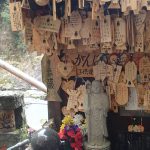
Pick up some sweet potatoes or vegetables at the road market at the entrance to Tsuetate and pop them in one of the free food steamers by the riverside carpark. While they’re cooking you could either enjoy a free footbath or take a walk around the riverside exploring the alleys and walkways.
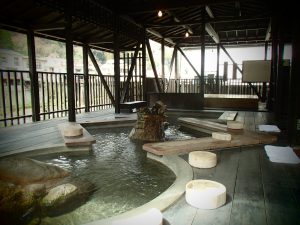
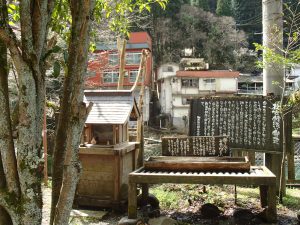
Look out for the money washing spot next to the footbath. Simply wash your money in the magical spring and your money will (reputedly) double!
Getting there
If you are visiting by public transport then take a local bus from Oguni town (if you are heading from Kumamoto prefecture) or from Hita town (from Fukuoka or Oita prefectures) , there are limited services so check the times going back before you head there.
If you are staying the night some of the hotels offer a free pick up service from Hita which is the nearest town.
If you are driving from Kumamoto head north from Oguni on route 212 for about 20 minutes. (Oguni is around 30 minutes drive from Daikanbo in northern Aso)
or
make life simple and put a stop off at Tsuetate Onsen into your customised Kurokawa or Around Aso tour.
[codepeople-post-map]


